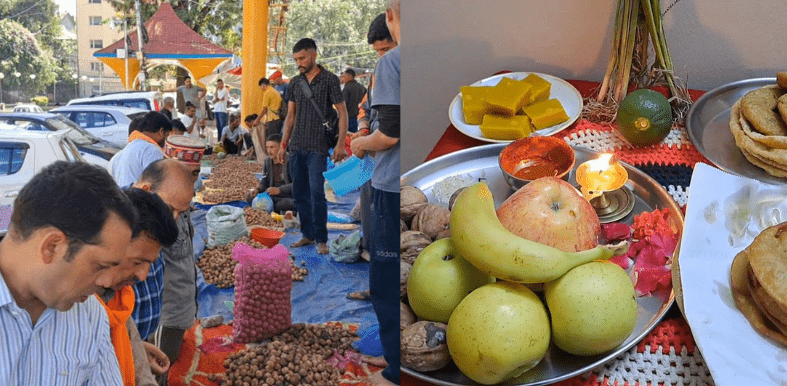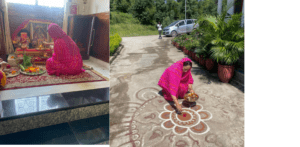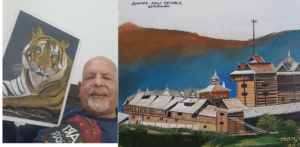Sair festival: Celebrating end of monsoon, onset of winter with tradition & joy

- Mandi to Host Mr. and Miss Northern India Semi-Finals on November 5 - November 2, 2024
- Congress MLAs Seek Cabinet Position as Sukhu Government Approaches Two-Year Milestone - November 2, 2024
- From Scalpel to Canvas: Dr. Om Mahendru’s Artistic Renaissance - November 2, 2024
MANDI: Sair festival, an ancient tradition marking the transition from monsoon to winter, is celebrated with great fervour across Himachal Pradesh.
The picturesque state of Himachal Pradesh is known not only for its natural beauty but also for its rich cultural heritage, deeply rooted in its festivals. Among these is the traditional Sair Festival, celebrated with enthusiasm and devotion every year as a way to mark the end of the monsoon season and the arrival of winter. The festival holds special significance for the rural communities, symbolising the end of the agricultural season and the beginning of harvest rituals.
Historical and cultural roots of Sair
Sair is celebrated primarily in the rural parts of Himachal Pradesh, including districts like Mandi, Kullu, Solan, Shimla and Sirmaur. Although the festival has ancient roots, its exact origins are unclear. However, it is believed to date back to times when agriculture was the primary occupation, and festivals like Sair served as communal occasions to give thanks for the monsoon and to celebrate the successful cultivation of crops.
Sair falls on the first day of the month of Ashwin in the Hindu calendar, marking the end of Bhadon (the last month of monsoon). Traditionally, it was seen as a way to express gratitude for the rains that nourished the fields and to usher in the winter season, a time for sowing winter crops. Over time, Sair has evolved into a social and cultural celebration, bringing communities together in a spirit of gratitude and festivity.
Rituals, traditions: Festival of new beginnings
One of the most distinctive aspects of Sair is the ritual worship of the season’s first harvest. On this day, people in rural areas worship newly harvested crops such as maize, rice, walnuts, and fruits like ‘galgal’ (a citrus fruit). The festival is observed with prayers for prosperity, and homes are decorated with freshly harvested crops to signify abundance and blessings for the coming winter months.
In many homes, families gather early in the morning to prepare for the day. Special dishes are made using seasonal ingredients, and the festival begins with the ceremonial offering of crops to the local deities. The rakhi, which was tied during the Raksha Bandhan festival, is ceremonially removed and offered to the Sair bonfire, symbolising the transition from one season to another.
Community celebrations and traditional games
A significant aspect of the Sair Festival is the community spirit it fosters. People come together to exchange greetings and gifts, traditionally offering walnuts and ‘dhruva’ (a type of sacred grass) as symbols of goodwill and prosperity. In earlier times, walnuts were also used for games where people would compete in breaking the hardest walnut shells, a custom that has faded over time but remains a cherished memory for older generations.
Marketplaces in towns and cities come alive during Sair, as farmers from nearby villages bring their harvested produce to sell. Urban dwellers, who don’t have the opportunity to harvest their own crops, purchase these items to partake in the rituals and festivities. This brings a unique rural-urban connection to the festival, reinforcing the bond between city residents and the agricultural roots of the region.
Flourishing walnut trade and economic impact
The Sair Festival has a significant economic impact, especially in terms of the walnut trade. During the festival, large quantities of walnuts are harvested and sold, making it a vital time for walnut farmers in Himachal Pradesh. Walnuts, being rich in nutrients and known for their health benefits, are a key part of winter diets in the region. As a result, families stock up on walnuts during Sair, ensuring they have enough for the colder months.
Festival for the future
While Sair remains a vibrant part of Himachal Pradesh’s cultural landscape, modernization has led to changes in how the festival is celebrated. The once prevalent games with walnuts are now rare, and in many urban areas, the rituals have been simplified. However, the essence of the festival — the gratitude for a bountiful harvest, the celebration of community, and the marking of seasonal change — remains strong.
Sair continues to be an occasion that brings people together, reminding them of their connection to the land, the changing seasons, and to each other. For the people of Himachal Pradesh, this ancient festival is more than just a seasonal celebration — it’s a tribute to the resilience and beauty of rural life, and a way to honor the cycles of nature that sustain their way of life.




